Martinique |
|
|
|
| Übersicht – Contents: | |
Diese Seite ist Teil des Projektes
Martinique |
|
|
|
| Übersicht – Contents: | |
Flaggen – Flag: |
|
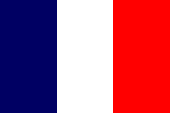 |
die Flagge
Frankreichs |
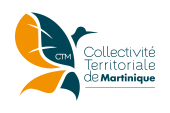 |
seit /since 2016, |
inoffizielle Flaggen – unofficial Flags: |
|
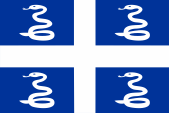 |
Schlangenflagge - Snake flag   |
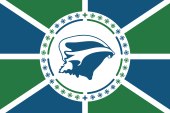 |
Ipséité-Flagge – Ipséité flag |
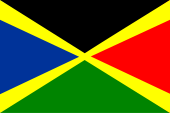 |
Taekwondo-Flagge – Taekwondo flag |
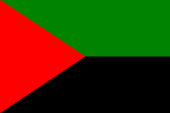 |
Rot-grün-schwarze Flagge |
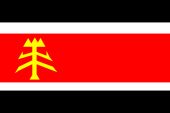 |
Flagge der MIM-Unabhängigkeitsbewegung |
| Alle französischen Kolonien, hatten über lange Zeit keine eigene Flagge. Es musste die französische Trikolore gehisst werden. Das gilt im Prinzip bis heute. Der Status der Kolonien änderte sich über die Jahre. Einige sind heute Überseedepartements, und damit ein ultraperipherischer Teil Frankreichs und auch der EU; andere sind Überseegemeinschaften, die autonom sind, und nicht Teil Frankreichs oder der EU. Überseedepartements gehören – nicht wie die Departements des Mutterlandes – zu keiner administrativen Region Frankreichs, sondern bilden eine eigene Region. |
All French colonies had no own flag over a long period. It had to be hoisted the French tricolor. This in principle usual until today.
The status of the colonies changed over the years. Some of them are now overseas departments, and thus a ultraperipheric part of France and of the EU; others are overseas communities, autonomous, and not a part of France or the EU. Overseas departments belong – in contrast to the departments of the motherland – to no administrative region of France, they are a separate region. |
| Die Gebietskörperschaft muss demzufolge offiziell die Flagge Frankreichs verwenden, jedoch können der Generalrat als oberstes gewähltes Kollegialorgan eines französischen Départements und auch der Regionalrat als oberstes gewähltes Kollegialorgan einer französischen Region eigene Flaggen haben. | The territorial entity has therefore officially to use the flag of France. However, the General Council as the highest elected collegial body of a French Department and the Regional Council as the highest elected collegial body of a French Region can have their own flags. |
| Diese Départements- und Regionsflaggen haben allerdings oft das Erscheinungsbild von Firmenflaggen mit Logos oder gar stilisierten Bildern, wirken lieblos, unhistorisch, technokratisch und modernistisch, denn im streng zentralistischen Frankreich wird jedwede Regionalität oder gar ein Bezug zur Geschichte vermieden. Darum sind diese Regions-Logo-Flaggen unbeliebt und werden kaum benutzt. | These flags of departments and regions, however, have oftenly the appearance of company flags with logos or even stylized images, appear carelessly, ahistorical, technocratic and modernist, because in the strictly centralist France is avoided any regionalism or even a historical subscription. Because of that these logo flags of regions are unpopular and are rarely used. |
| Mit einer Verwaltungsreform im Jahre 2015 wurden Generalrat und Regionalrat zusammeglegt, die Gebietskörperschaft erhielt den Status einer "Collectivité territoriale unique" und es wurde eine Flagge für die Gebietskörperschaft angenommen. Das ist eine weiße Logo-Flagge modernistischen Zuschnitts mit der Silhouette eines Vogels und einer Inschrift. |
On the occasion of an administrative reform in 2015, the General Council and
the Regional Council were merged, the territorial entity was given the
status of a "Collectivité territoriale unique" and a flag was adopted for
that territorial entity. It is a white logo-flag of modernist design with the silhouette of a bird and an inscription. |
| Für lokale und touristische Zwecke gibt es jedoch – wie bei fast allen französischen Besitzungen üblich – noch die bekannten und beliebten Wappen-Flaggen. Dazu wird das Bild des Wappenschilds des Landes auf ein Flaggentuch übertragen. | But, there exist, for local and tourist purposes – usual in almost all French possessions - the famous and popular crest flags, where the image of the Coat of Arms of the country is transferred to a bunting. |
| Diese Flagge wurde 1766 geschaffen und zeigt eine Gestaltung ähnlich der damaligen französischen Handelsflagge, ein weißes Kreuz auf blauem Grund. Damit wird die Zugehörigkeit zum Mutterland Frankreich zum Ausdruck gebracht. In den vier blauen Feldern sind Martinique-Lanzenottern zu sehen, eine Schlangenart, die nur hier auf Martinique vorkommt. | This flag was created in 1766 and shows the design similar to the French merchant flag of that time, a white cross on blue ground. Therewith is expressed the affiliation to the motherland France. In the four blue fields appear Martinique Terciopelos, a kind of snakes, which is to see only here, on Martinique. |
| Diese Flagge wird angeblich nur von der europäischstämmigen Bevölkerung verwendet und war teilweise auch offziell in Gebrauch, so auch auf den Uniformen der Gendamerie, was nicht verwunderlich ist, sie zeigt ja das Bild des Wappens von Martinique. Seit 2017 ist diese Flagge umstritten, sie wird mit der Sklaverei in Verbindung gebracht. Im Jahre 2018 verbot der französische Präsident jegliche Nutzung durch Landesbehörden. |
This flag is supposedly only used by the population of European descent and
was sometimes officially in use, including on the uniforms of the
Gendamerie, which is not surprising as it shows the image of the coat of
arms of Martinique. Since 2017, this flag has been controversial, being associated with slavery. In 2018, the French president banned any use by national authorities. |
| Im Jahre 2019 wurde eine neue inoffzielle Flagge vorgestellt, die Martinique bei internationalen Sport- oder Kulturveranstaltungen repräsentieren sollte. Sie nannte sich "Ipséité" was mit "Eigenständigkeit" zu übersetzen wäre. Sie zeigt geständert (gyronny) die Farben Grün, Blau und Weiß und in der Mitte eine Lambi-Muschel (Lobatus gigas), ein allgemeines Symbol der Westindischen Inseln, als ein traditionelles Musikinstrument. Per Gerichtsbeschluss wurde diese Flagge als illegal festgestellt und deren Verwendung eingestellt. |
In 2019, a new unofficial flag was presented to represent Martinique at
international sporting or cultural events. It was called "Ipséité", which could be translated as "Selfhood". It shows the colours green, blue and white in gyronny style and a lambi shell (Lobatus gigas) in the middle, a common symbol of the West Indies, as a traditional musical instrument. By court order, this flag was found to be illegal and its use was discontinued. |
| Bei einer Minderheit der Bevölkerung ist eine rot-grün-schwarze Flagge beliebt, sie zeigt zwei Streifen in Grün und Schwarz und ein rotes Dreieck am Mast. Sie wird von diversen nationalistischen und separatistischen Gruppen und Parteien verwendet, außer von der MIM (Martinican Independence Movement). Es wird berichtet, diese Farben sollen schon während eines Sklavenaufstandes im Jahre 1665 verwendet worden sein. In Wirklichkeit dürften die Farben auf die 60-er Jahre zurückgehen, und zwar auf Marcus Garvey. Die Flagge in der Form mit dem roten Dreieck wurde im Jahre 1971 in Martinique bekannt. Per Gerichtsbeschluss wurde die Verwendung dieser Flagge durch Behörden als illegal festgestellt. |
A red-green-black flag is popular among a minority of the population; it
shows two stripes in green and black and a red triangle on the flag-pole.
It is used by various nationalist and separatist groups and parties, except the MIM (Martinican Independence Movement). It is reported that these colours were already used during a slave revolt in 1665. In reality, the colours probably date back to the 1960s, to Marcus Garvey. The flag in the shape with the red triangle became known in Martinique in 1971. By court order, the use of this flag by authorities was found to be illegal. |
| Die Farbenkomination aus Rot, Schwarz und Grün wird Garvey-Farben genannt. Es sind die Farben, die Markus Garvey 1917 für die Flagge der United Negro Improvement Association schuf und die in diesen Farben gestreift war. Er war ein Befürworter der "Zurück nach Afrika"-Bewegung und sah in diesen Farben diejenigen eines Staates für Schwarze, der in Afrika entstehen sollte. Die Farben wurden dann aber in den USA und der Karibik als diejenigen der Black-Power-Bewegung bekannt, fanden aber in Afrika nur wenig Zuspruch. Trotzem wird auch diese Farbenkombination manchmal als panafrikanische Farben bezeichnet. | The combination of the colours red, black and green is named Garvey-colours. They are those colours who created Markus Garvey in 1917 for the flag of the United Negro Improvement Association, which was striped in this colours. He was a supporter of the "Back-to-Africa"-Movement and saw in them the colours of a state for Blacks, which should be accomplished in Africa. But the colours get known in the USA and in the Caribic as the colours of the Black-Power-Movement, and get in Africa few persuasion. Nevertheless this colour-combination is sometimes named as Panafrican Colors. |
| Eine weitere Flagge in den Farben Schwarz, Rot, Blau und Grün mit einem gelben Diagonalkreuz darüber wird bei internationalen Taekwondo-Wettkämpfen gezeigt. Ob sie das Land repräsentieren soll oder vielleicht die Flagge des Taekwondo Landesverbands ist, ist nicht bekannt. |
Another flag in the colours black, red, blue and green with a yellow
diagonal cross above it is displayed at international Taekwondo
competitions. Whether it is meant to represent the country or is perhaps the flag of the Taekwondo national association is not known. |
| Quelle/Source: Wikipedia (FR), Wikipedia (EN), Volker Preuß | |
| Wappen – Coat of arms: | |
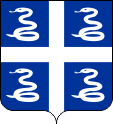 |
Wappen von Martinique – coat of arms of Martinique, Quelle/Source, nach/by: Wikipedia (FR) |
| Das Wappen geht auf eine Flagge zurück, die im Jahre 1766 geschaffen wurde und eine Gestaltung ähnlich der damaligen französischen Handelsflagge zeigt, ein weißes Kreuz auf blauem Grund. Damit wird die Zugehörigkeit zum Mutterland Frankreich zum Ausdruck gebracht. In den vier blauen Feldern sind Martinique-Lanzenottern zu sehen, eine Schlangenart, die nur hier auf Martinique vorkommt. Allerdings hat das Wappen keinen offziellen Charakter, es sind die Symbole Frankreichs bzw. das Logo der Gebietskörperschaftzu verwenden. |
The The coat of arms goes back to a flag that was created in 1766 and shows a design
similar to the French merchant flag of that time, a white cross on blue ground. Therewith
is expressed the affiliation to the motherland France. In the four blue fields appear
Martinique Terciopelos, a kind of snakes, which is to see only here, on Martinique.
However, the coat of arms has no official character, the symbols of France or the logo of the territorial collectivity are to be used. |
| Quelle/Source: Wikipedia (FR) | |
| Landkarte – Map: |
|
| Zahlen und Fakten – Numbers and Facts: | |
|
|
|
|
|
|
|
|
|
|
|
|
|
|
|
|
| Quelle/Source: Wikipedia (D) | |
|
1502 · von Kolumbus entdeckt 1635 · beginnende französ. Kolonisierung 1664 · französische Kolonie 1848 · Aufhebung der Sklaverei 1946 · Überseedépartement 2015 · Verwaltungsreform, Generalrat und Regionalrat werden zusammengelegt, das Land wird eine "Collectivité territoriale unique" |
|
1502 · discovered by Columbus 1635 · beginning French colonization 1664 · French colony 1848 · abolition of the slavery 1946 · Overseas Department 2015 · administrative reform, General Council and Regional Council are merged, the country becomes a "Collectivité territoriale unique" |
| Quelle/Source: Wikipedia (D) |
| Der Name "Martinique" könnte
französischen Ursprungs sein, stammt jedoch aus der Spache der Kariben und
heißt übersetzt: "Blumeninsel". | The name "Martinique" could be of French origin, but
it comes from the language of the Caribs and means translated: "Flowers Island". |
| Quelle/Source: Handbuch der geographischen Namen | |